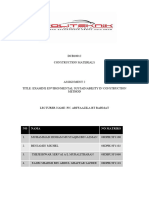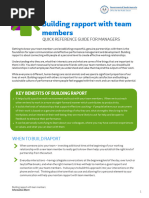Green Building Materials-2
Green Building Materials-2
Uploaded by
Abhiram P RCopyright:
Available Formats
Green Building Materials-2
Green Building Materials-2
Uploaded by
Abhiram P RCopyright
Available Formats
Share this document
Did you find this document useful?
Is this content inappropriate?
Copyright:
Available Formats
Green Building Materials-2
Green Building Materials-2
Uploaded by
Abhiram P RCopyright:
Available Formats
See discussions, stats, and author profiles for this publication at: https://www.researchgate.
net/publication/376417888
GREEN BUILDING MATERIALS
Article in INTERANTIONAL JOURNAL OF SCIENTIFIC RESEARCH IN ENGINEERING AND MANAGEMENT · December 2023
DOI: 10.55041/IJSREM27437
CITATION READS
1 1,258
1 author:
Gayathri S Shivakumar
BMS School of Architecture
6 PUBLICATIONS 1 CITATION
SEE PROFILE
All content following this page was uploaded by Gayathri S Shivakumar on 10 January 2024.
The user has requested enhancement of the downloaded file.
International Journal of Scientific Research in Engineering and Management (IJSREM)
Volume: 07 Issue: 12 | December - 2023 SJIF Rating: 8.176 ISSN: 2582-3930
GREEN BUILDING MATERIALS
Gayathri S Shivakumar
Associate Professor, BMS School of Architecture, Bengaluru, gayathrisrinivas.1920@gmail.com
ABSTRACT:
The adoption of green building materials has become paramount in the global construction industry to
mitigate environmental impact and promote sustainable development. This research paper provides a
comprehensive review of green building materials, their significance, and their impact on sustainable
construction practices. It discusses the various categories of green building materials, their advantages,
challenges, and the latest developments in this field.
INTRODUCTION
The use of green building materials has gained considerable significance in recent years as societies
worldwide strive to address environmental concerns and promote sustainable development. Green building
materials play a pivotal role in constructing structures that minimize their impact on the environment
throughout their lifecycle, from production to construction, occupancy, and eventual demolition or
deconstruction.
The significance of green building materials lies in their ability to mitigate the environmental footprint
associated with traditional construction practices. These materials are designed and selected with a focus
on reducing resource consumption, energy usage, and waste generation. They contribute to the creation of
environmentally responsible buildings that are not only energy-efficient but also healthier for occupants.
One key aspect of the significance of green building materials is their potential to enhance energy
efficiency. Many green materials possess superior insulating properties, helping to regulate indoor
temperatures and reduce the need for excessive heating or cooling. This, in turn, lowers energy
consumption, leading to decreased greenhouse gas emissions and a smaller overall environmental impact.
Another critical dimension is the conservation of natural resources. Traditional construction materials often
involve the extraction of non-renewable resources, contributing to habitat destruction and ecosystem
© 2023, IJSREM | www.ijsrem.com DOI: 10.55041/IJSREM27437 | Page 1
International Journal of Scientific Research in Engineering and Management (IJSREM)
Volume: 07 Issue: 12 | December - 2023 SJIF Rating: 8.176 ISSN: 2582-3930
degradation. Green building materials, on the other hand, are frequently sourced from rapidly renewable or
recycled materials, minimizing the depletion of finite resources and promoting a more circular economy.
Furthermore, green building materials prioritize indoor air quality and occupant health. Many conventional
construction materials emit volatile organic compounds (VOCs) and other pollutants that can adversely
affect the well-being of those within a structure. Green materials are selected for their low VOC emissions
and non-toxic properties, fostering healthier living and working environments.
KEY CHARACTERISTICS OF GREEN BUILDING MATERIALS:
1. Resource Efficiency: Green building materials are often sourced from renewable or recycled
materials, reducing the demand for virgin resources.They aim to minimize resource extraction,
depletion, and the environmental impact associated with traditional building materials.
2. Energy Efficiency: The production, transportation, and installation of green building materials
typically involve lower energy consumption compared to conventional materials. These materials
may contribute to better insulation and energy performance in buildings, reducing the need for
artificial heating or cooling.
3. Reduced Environment Impact: Green building materials aim to minimize environmental
pollution, emissions, and waste generation during manufacturing, use, and disposal. They may have
lower levels of harmful chemicals and pollutants, contributing to healthier indoor air quality.
4. Durability and Longevity: Green building materials are often selected for their durability and long
lifespan, reducing the frequency of replacements and the associated environmental impact. Durable
materials contribute to the longevity and resilience of buildings.
5. Recyclability and Reusability: Many green building materials are designed to be recyclable or
reusable at the end of their life cycle, promoting a closed-loop system. Recycling and reusing
materials help minimize waste and conserve resources.
6. Renewable Materials: Green building materials may be derived from rapidly renewable resources,
such as bamboo, cork, or certain types of wood that can be harvested sustainably. These materials
are replenished quickly, reducing the depletion of finite resources.
7. Low Embodied Carbon: The embodied carbon of a material refers to the total greenhouse gas
emissions associated with its production, transportation, and installation. Green building materials
often have a lower embodied carbon compared to traditional counterparts.
© 2023, IJSREM | www.ijsrem.com DOI: 10.55041/IJSREM27437 | Page 2
International Journal of Scientific Research in Engineering and Management (IJSREM)
Volume: 07 Issue: 12 | December - 2023 SJIF Rating: 8.176 ISSN: 2582-3930
8. Water Efficiency: Some green building materials focus on water conservation, either by using less
water during production or by contributing to efficient water use within buildings. Water-efficient
materials may also help manage stormwater runoff effectively.
9. Biodegradability: Certain green building materials are designed to be biodegradable, meaning they
can naturally break down at the end of their life cycle without causing harm to the environment.
10. Innovation and Advancements: Green building materials often incorporate innovative
technologies and advancements to improve their sustainability and performance.
CATEGORIES OF GREEN BUILDING MATERIALS:
RECYCLED BUILDING MATERIALS RECLAIMED BUILDING MATERIALS
1. Recycled Concrete Aggregate 1. Reclaimed Brick
2. Recycled Steel 2. Reclaimed Wood Flooring
3. Recycled Plastic 3. Reclaimed Metal
4. Recycled Glass 4. Reclaimed Stone
5. Recycled Wood 5. Reclaimed Glass Blocks
BENEFITS OF USING RECYCLED & RECLAIMED MATERIALS:
▪ Environmental Conservation: Reduces the need for new resource extraction and
minimizes the environmental impact associated with the production of virgin materials.
▪ Waste Reduction: Diverts construction and demolition waste from landfills, contributing
to sustainable waste management practices.
▪ Energy Savings: Requires less energy in processing compared to the production of new
materials, leading to lower carbon emissions.
▪ Preservation of Character: Gives a unique and historical character to structures by
incorporating materials with a history.
▪ Economic Benefits: Supports local economies by salvaging and reusing materials locally,
creating job opportunities in the reclamation and recycling industries.
Incorporating recycled and reclaimed building materials into construction projects aligns with
sustainable building practices and promotes a more circular and environmentally friendly
approach to the construction industry.
© 2023, IJSREM | www.ijsrem.com DOI: 10.55041/IJSREM27437 | Page 3
International Journal of Scientific Research in Engineering and Management (IJSREM)
Volume: 07 Issue: 12 | December - 2023 SJIF Rating: 8.176 ISSN: 2582-3930
The following types of materials are used in the green building construction.
1. Bamboo
2. Recycled Steel
3. Rammed Earth
4. Hempcrete
5. Straw Bales
6. Recycled Plastic Lumber
7. Cork
Low Impact Building Materials
8. Reclaimed Wood
9. Solar Tiles
10. Cellulose Insulation
11. Natural Fiber Carpets
12. Low VOC Paints
13. Permeable Paving
1. Wood
2. Bamboo
3. Cork
4. Straw Bales
5. Hempcrete
6. Linoleum
Renewable Materials 7. Coconut Timber
8. Rattan Vine
9. Sunflower Husks
10. Wool Insulation
11. Recycled Cotton
12. Mycelium Board
1. Local Timber
2. Stone
Locally Sourced Materials
3. Bricks
4. Adobe or Earth Blocks
© 2023, IJSREM | www.ijsrem.com DOI: 10.55041/IJSREM27437 | Page 4
International Journal of Scientific Research in Engineering and Management (IJSREM)
Volume: 07 Issue: 12 | December - 2023 SJIF Rating: 8.176 ISSN: 2582-3930
5. Gravel & Aggregates
6. Clay
7. Reclaimed or Salvaged Materials
8. Local Metal
9. Local Concrete
10. Local Insulation Materials
11. Regional Plants for Landscaping
1. Cellulose Insulation
2. Sheep’s Wool Insulation
3. Cotton Insulation
4. Recycled PET Insulation
5. Hemp Insulation
6. Cork Insulation
7. Recycled Fiberglass Insulation
8. Aerogel Insultion
Eco friendly Insulation
9. Polystyrene-Free Insulation
10. Mycelium Insulation
11. Straw Bales
12. Aircrete Blocks
13. Natural Fiber Boards
14. Wood Fiber Insulation
15. Recycled Rubber Insulation
1. Low VOC Paints
2. Natural Clay Plaster
3. Natural Fiber Carpets
4. Lineleum Flooring
Non-Toxic Materials
5. Cork Flooring
6. Natural Hardwood Flooring
7. Gypsum Board with Low Voc Adhesives
8. Natural Insulation Materials
© 2023, IJSREM | www.ijsrem.com DOI: 10.55041/IJSREM27437 | Page 5
International Journal of Scientific Research in Engineering and Management (IJSREM)
Volume: 07 Issue: 12 | December - 2023 SJIF Rating: 8.176 ISSN: 2582-3930
9. Unpainted or Unfinished Wood Furniture
10. Bamboo Flooring
11. Recycled Glass Countertops
12. Natural Stone
13. Natural Fiber Wall Coverings
14. Non-Toxic Sealants and Adhesives
15. Recycled Metal
ADVANTAGES OF GREEN BUILDING MATERIALS:
Environmental Benefits:
1. Resource Conservation: Green building materials often involve the use of recycled,
reclaimed, or rapidly renewable resources, reducing the demand for virgin materials and
minimizing the depletion of natural resources.
2. Energy Efficiency: Many green materials contribute to improved energy efficiency in
buildings. For example, better insulation materials reduce the need for heating and cooling,
leading to reduced energy consumption and lower greenhouse gas emissions.
3. Reduced Carbon Footprint: The production of traditional construction materials can be
energy-intensive and result in significant carbon emissions. Green materials, such as
recycled steel or low-impact concrete, often have a lower carbon footprint, contributing to
overall emissions reduction.
4. Waste Reduction: Green building practices prioritize minimizing construction and
demolition waste by using materials that are recyclable, reusable, or biodegradable. This
reduces the burden on landfills and promotes a more sustainable approach to waste
management.
5. Improved Indoor Air Quality: Many green materials are selected for their low emissions of
volatile organic compounds (VOCs) and other harmful substances, contributing to healthier
indoor air quality and reducing the risk of respiratory issues.
6. Water Conservation: Some green building materials, such as low-flow plumbing fixtures
and water-efficient landscaping materials, contribute to water conservation, addressing
concerns related to water scarcity.
© 2023, IJSREM | www.ijsrem.com DOI: 10.55041/IJSREM27437 | Page 6
International Journal of Scientific Research in Engineering and Management (IJSREM)
Volume: 07 Issue: 12 | December - 2023 SJIF Rating: 8.176 ISSN: 2582-3930
7. Biodiversity Preservation: Some green building materials, such as low-flow plumbing
fixtures and water-efficient landscaping materials, contribute to water conservation,
addressing concerns related to water scarcity.
Economic Benefits
1. Energy Cost Savings: Green building materials and energy-efficient design features can
result in lower energy consumption, leading to reduced energy costs over the operational
life of a building.
2. Long-Term Cost Savings: Green building materials and energy-efficient design features can
result in lower energy consumption, leading to reduced energy costs over the operational
life of a building.
3. Job Creation: The production and installation of green building materials contribute to job
creation in the sustainable construction and manufacturing sectors.
4. Increased Property Value: Green buildings are often perceived as more valuable due to their
energy efficiency, sustainable features, and lower operating costs. This can result in
increased property values and market demand.
5. Incentives and Certifications: Governments and organizations often provide incentives, tax
credits, or certifications for green building practices, encouraging the adoption of
environmentally friendly materials and construction methods.
Health Benefits
1. Improved Indoor Air Quality: Low-emission and non-toxic materials contribute to healthier
indoor air quality, reducing the risk of respiratory issues, allergies, and other health problems
associated with poor air quality.
2. Natural Light & Ventilation: Green building design often incorporates features like ample
natural light and effective ventilation, promoting a more comfortable and healthier indoor
environment.
3. Noise Reduction: Some green materials, such as natural fiber insulation or acoustic panels,
contribute to noise reduction, creating a more pleasant and stress-free indoor environment.
4. Biophilic Design: Incorporating natural elements and green spaces in building design
(biophilic design) has been shown to reduce stress, enhance mood, and improve overall
mental well-being.
© 2023, IJSREM | www.ijsrem.com DOI: 10.55041/IJSREM27437 | Page 7
International Journal of Scientific Research in Engineering and Management (IJSREM)
Volume: 07 Issue: 12 | December - 2023 SJIF Rating: 8.176 ISSN: 2582-3930
CONCLUSION
The adoption of green building materials offers a holistic approach to sustainable construction,
benefiting the environment, the economy, and the health and well-being of building occupants.
As awareness of these benefits grows, there is an increasing trend toward incorporating green
building practices into construction projects worldwide.
REFERENCES
1. Title: Sustainable construction—definitions and evaluations Authors: A. K. Bakar, A. R. OthmanJournal:
Renewable and Sustainable Energy Reviews Year: 2015 DOI: 10.1016/j.rser.2014.12.046
2. Title: A review on the sustainability of natural fiber in polymer matrix Authors: M. K. Mohanty, M. Misra,
L. T. Drzal Journal: Composites Part A: Applied Science and Manufacturing Year: 2002 DOI:
10.1016/s1359-835x(02)00039-6
3. Title: A review on the growing use of structural bamboo: The material properties, applications, challenges,
and future directions Authors: T. L. S. Cheung, G. C. Pritchard Journal: Sustainability Year: 2016
DOI: 10.3390/su8090766
4. Title: A review on the use of bamboo in earthquake-prone areas Authors: A. M. Saleh, R. D. Sutjipto,
D. A. Walubita Journal: Journal of Building Performance Year: 2018 DOI:
10.1080/19401493.2017.1360723
5. Title: Sustainable construction materials: Recycled and waste materials in concrete technology Authors:
S. K. Singh, P. Rai Journal: Sustainability of Constructions: Towards a Better Built Environment Year:
2016 DOI: 10.1007/978-81-322-2646-3_2
6. Title: A review on basalt fiber and its composites Authors: N. J. Bunakkharas, A. F. M. Arif Journal:
Composites Part B: Engineering Year: 2013 DOI: 10.1016/j.compositesb.2012.11.001
7. Title: Bamboo as a building material—its utilization in the developing world Authors: S. N. Mukherjee
Journal: Building and Environment Year: 2003 DOI: 10.1016/S0360-1323(02)00111-4
8. Title: Eco-efficient concrete: Opportunities and challenges Authors: F. Pacheco-Torgal, C. Labrincha, P.
Leonelli, et al. Journal: Cement and Concrete Research Year: 2013 DOI:
10.1016/j.cemconres.2013.02.001
9. Title: A review on sustainable design and construction using bamboo Authors: T. R. Naik, R. L. Carriço, M.
C. A. Oliveira Journal: Construction and Building Materials Year: 2014 **DOI:
[10.1016/j.conbuildmat.201
© 2023, IJSREM | www.ijsrem.com DOI: 10.55041/IJSREM27437 | Page 8
View publication stats
You might also like
- Assessing Coastal Vulnerability Developing A Global Index For Measuring RiskDocument64 pagesAssessing Coastal Vulnerability Developing A Global Index For Measuring RiskkowsilaxNo ratings yet
- Green BuildingDocument60 pagesGreen BuildingRamnaresh Sharma86% (7)
- Sustainable Construction PDFDocument5 pagesSustainable Construction PDFTeddy MatiekaNo ratings yet
- Finnal Innovative Materials For Green Building ConstructionDocument8 pagesFinnal Innovative Materials For Green Building Constructionl236729No ratings yet
- Green Building For Public MarketDocument5 pagesGreen Building For Public MarketvirgilioNo ratings yet
- Report On Green Architecture: Bachelor of Architecture Tenth Semester (2019-2020)Document27 pagesReport On Green Architecture: Bachelor of Architecture Tenth Semester (2019-2020)Zaid Beg100% (1)
- Sustainable Building Materials and Their Impact On The Environment - 20231125 - 153256 - 0000Document16 pagesSustainable Building Materials and Their Impact On The Environment - 20231125 - 153256 - 0000ebsp7as7No ratings yet
- 2020-Me-182 HMT CepDocument10 pages2020-Me-182 HMT CepIyan MehmoodNo ratings yet
- 2020 Me 182Document17 pages2020 Me 182Iyan MehmoodNo ratings yet
- Green ArchitectureDocument12 pagesGreen ArchitectureJosielyn ArrezaNo ratings yet
- Green Buildings A ReviewDocument5 pagesGreen Buildings A ReviewSamar OmaraNo ratings yet
- Materials NotesDocument6 pagesMaterials NotesEr Lav Kush PrasadNo ratings yet
- Eco Friendly Building MaterialDocument32 pagesEco Friendly Building MaterialMeet BhalodiyaNo ratings yet
- Matterials Group Assignment 2Document14 pagesMatterials Group Assignment 2Benjamin MihelNo ratings yet
- Green BuildingDocument10 pagesGreen Buildingmr_mrsNo ratings yet
- GA - Lecture 07Document33 pagesGA - Lecture 07Leen RimawiNo ratings yet
- Green BuildingDocument27 pagesGreen BuildingramNo ratings yet
- DEVIDocument10 pagesDEVIDibyaranjan DasNo ratings yet
- Green Roofing Materials in Vernacular Residential BuildingsDocument11 pagesGreen Roofing Materials in Vernacular Residential BuildingsShantilal ANo ratings yet
- Green Buildings and Innovative Materials: Department of Civil EngineeringDocument12 pagesGreen Buildings and Innovative Materials: Department of Civil EngineeringGowtham KarthickNo ratings yet
- Sustainability 16 03283Document15 pagesSustainability 16 03283Jesus dzulNo ratings yet
- Sustainable Building Materials and TechniquesDocument3 pagesSustainable Building Materials and Techniquesselma.dahNo ratings yet
- Abera 2024 Sustainable Building Materials A Comprehensive Study On Eco Friendly Alternatives For ConstructionDocument17 pagesAbera 2024 Sustainable Building Materials A Comprehensive Study On Eco Friendly Alternatives For ConstructionmaniefasikaNo ratings yet
- Times21Document8 pagesTimes21faithatoma21No ratings yet
- Green ConcreteDocument13 pagesGreen ConcreteSanket Chaudhari100% (1)
- MODULE-4-Green Building MaterialsDocument42 pagesMODULE-4-Green Building MaterialsPriyanshi GahlotNo ratings yet
- Rma1 DGMT01 MarcosokmDocument34 pagesRma1 DGMT01 MarcosokmkaytieworksNo ratings yet
- MODULE-4-Green Building Materials - 19.02.24Document22 pagesMODULE-4-Green Building Materials - 19.02.24Vikram ChoudharyNo ratings yet
- Presentation 5Document14 pagesPresentation 5Kandagatla KamalNo ratings yet
- Vinay Updated Paper VJ ItDocument11 pagesVinay Updated Paper VJ ItVinay SainNo ratings yet
- Sustainable MaterialsDocument4 pagesSustainable Materialsr...No ratings yet
- Presentation 5Document14 pagesPresentation 5suchith reddy arukalaNo ratings yet
- Environmental Engineering: Green BuildingDocument5 pagesEnvironmental Engineering: Green BuildingfarinaazmiNo ratings yet
- Path To Sustainable BuildingsDocument14 pagesPath To Sustainable BuildingsStudy With DanishNo ratings yet
- Green Building Materials and Material EfficiencyDocument3 pagesGreen Building Materials and Material Efficiencyveenau 1No ratings yet
- Comparative Study of Conventional Concrete and Green Concrete Made of Fly Ash, Recycled Red Bricks and RecycledDocument11 pagesComparative Study of Conventional Concrete and Green Concrete Made of Fly Ash, Recycled Red Bricks and RecycledIJRASETPublicationsNo ratings yet
- Government Polytechnic Thane.: Micro-Project: Study of Green Building MaterialsDocument36 pagesGovernment Polytechnic Thane.: Micro-Project: Study of Green Building MaterialsOmkar Jambhale100% (1)
- Materials Used in Green Building ConstructionDocument22 pagesMaterials Used in Green Building Constructionsubeersubi720No ratings yet
- Green BuildingDocument41 pagesGreen BuildingVinayan ASNo ratings yet
- Green MaterialsDocument27 pagesGreen MaterialsKianHe ChanNo ratings yet
- Raajdhani Engineering College Bhubaneswar: Materials Used in Green Building ConstructionDocument21 pagesRaajdhani Engineering College Bhubaneswar: Materials Used in Green Building ConstructionBasanti HasdaNo ratings yet
- Green Building: Building The Future With IntentionDocument35 pagesGreen Building: Building The Future With IntentionHadee SaberNo ratings yet
- Eco FriendlyBuildingMaterialsExaminingSubstitutesDocument12 pagesEco FriendlyBuildingMaterialsExaminingSubstitutesDivyansh SinghNo ratings yet
- Faculty of Engineering & TechnologyDocument12 pagesFaculty of Engineering & TechnologySachin HarriramNo ratings yet
- Sustainable Architecture Topic-Sustainable MaterialsDocument9 pagesSustainable Architecture Topic-Sustainable MaterialsADITYANo ratings yet
- Desertation On Thesis: Topic: Green BuildingDocument24 pagesDesertation On Thesis: Topic: Green Buildinga_j_sanyal259No ratings yet
- Green BuildingDocument29 pagesGreen BuildingsadafScribd100% (2)
- PreetDocument17 pagesPreetMAHESH SHUKLANo ratings yet
- Research AT 319Document24 pagesResearch AT 319DEMINo ratings yet
- 6367Document3 pages6367Pradeep AryaNo ratings yet
- Sap-Unit 3Document44 pagesSap-Unit 3bryson solomonNo ratings yet
- Use of Sustainable Green Materials in ConstructionDocument11 pagesUse of Sustainable Green Materials in ConstructionVaishnavi J RamNo ratings yet
- Green ConcreteDocument22 pagesGreen ConcretesandhyaNo ratings yet
- Sustainability in Buildings-2 (Material Usage) : Hüseyin KARADADAŞDocument42 pagesSustainability in Buildings-2 (Material Usage) : Hüseyin KARADADAŞfpsqweNo ratings yet
- Green Building MaterialsDocument102 pagesGreen Building MaterialsMartyNo ratings yet
- Ajce 20231103 11Document6 pagesAjce 20231103 11tomie sellsNo ratings yet
- Green .ConstructionDocument8 pagesGreen .Constructionparvathybnair06No ratings yet
- Green Building - Seminar ReportDocument41 pagesGreen Building - Seminar ReportshijilackcltNo ratings yet
- Experimental Study On Green ConcreteDocument5 pagesExperimental Study On Green ConcreteMaria HanyNo ratings yet
- Pradeep Choudhary r PaperDocument3 pagesPradeep Choudhary r PaperPradeep AryaNo ratings yet
- Green Architecture: A Guide To Understanding Characteristics of Sustainable BuildingsFrom EverandGreen Architecture: A Guide To Understanding Characteristics of Sustainable BuildingsNo ratings yet
- Networking as a strategy to business developmentDocument9 pagesNetworking as a strategy to business developmentAbhiram P RNo ratings yet
- TNMAS00520280000087500Document3 pagesTNMAS00520280000087500Abhiram P RNo ratings yet
- Prompt List - Ai InfluencerDocument3 pagesPrompt List - Ai InfluencerAbhiram P RNo ratings yet
- Future CLUBDocument4 pagesFuture CLUBAbhiram P RNo ratings yet
- 25 social media posts EnglishDocument9 pages25 social media posts EnglishAbhiram P RNo ratings yet
- INFLUENCING AND PERSUASION TECHNIQUES USED __DURING INITIAL ONE-TO-ONE NEGOTIATIONSDocument11 pagesINFLUENCING AND PERSUASION TECHNIQUES USED __DURING INITIAL ONE-TO-ONE NEGOTIATIONSAbhiram P RNo ratings yet
- The Main Criteria for Lead GenerationDocument6 pagesThe Main Criteria for Lead GenerationAbhiram P RNo ratings yet
- 31-23-0019349-00Document2 pages31-23-0019349-00Abhiram P RNo ratings yet
- Reimbursement Approval LetterDocument3 pagesReimbursement Approval LetterAbhiram P RNo ratings yet
- The 10 Habits of Highly Successful (and Deeply) Happy PeopleDocument2 pagesThe 10 Habits of Highly Successful (and Deeply) Happy PeopleAbhiram P RNo ratings yet
- Receipt pay_PhCjh0RWSUtju2 from Dip Kumar (Paid)Document1 pageReceipt pay_PhCjh0RWSUtju2 from Dip Kumar (Paid)Abhiram P RNo ratings yet
- OpenAccessbookonBusinessModelInnovationGameChangersPalgrave2024Document3 pagesOpenAccessbookonBusinessModelInnovationGameChangersPalgrave2024Abhiram P RNo ratings yet
- Business NetworkingDocument26 pagesBusiness NetworkingAbhiram P RNo ratings yet
- Receipt pay_PhKLBMTJMO1cwl from OPEN BOX Consulting (Paid)Document1 pageReceipt pay_PhKLBMTJMO1cwl from OPEN BOX Consulting (Paid)Abhiram P RNo ratings yet
- HowToClose9OutOf102022Document17 pagesHowToClose9OutOf102022Abhiram P RNo ratings yet
- 8 Personality Development Skills You Must PossessDocument19 pages8 Personality Development Skills You Must PossessAbhiram P RNo ratings yet
- JD FSC Banca-FrontlineDocument1 pageJD FSC Banca-FrontlineAbhiram P RNo ratings yet
- 003 Building Rapport With Team MembersDocument3 pages003 Building Rapport With Team MembersAbhiram P RNo ratings yet
- Refresh Your Morning RoutineDocument1 pageRefresh Your Morning RoutineAbhiram P RNo ratings yet
- Mastering High Ticket SalesDocument18 pagesMastering High Ticket SalesAbhiram P RNo ratings yet
- Product ReccomendationDocument9 pagesProduct ReccomendationAbhiram P RNo ratings yet
- Urban Watershed Management Under Rapid Urbanization: EditorialDocument1 pageUrban Watershed Management Under Rapid Urbanization: EditorialakhmadNo ratings yet
- Handbook of Climate Change and Biodiversity (Walter Leal Filho, Jelena Barbir Etc.)Document406 pagesHandbook of Climate Change and Biodiversity (Walter Leal Filho, Jelena Barbir Etc.)snunesfeio100% (1)
- Diversity of Fresh Water Algae From The Sahastrakund Waterfall, Nanded, MaharashtraDocument6 pagesDiversity of Fresh Water Algae From The Sahastrakund Waterfall, Nanded, MaharashtraFadhli AuliaNo ratings yet
- Landscape As A Geosystem ArtDocument33 pagesLandscape As A Geosystem ArtMARIA VICTORIA VELARDE ALIAGANo ratings yet
- Icopal MS 112 M - 16.04.2015 ENGDocument1 pageIcopal MS 112 M - 16.04.2015 ENGSorin NitaNo ratings yet
- Making A Living, Sustainably: Green Jobs Sustainability CareersDocument12 pagesMaking A Living, Sustainably: Green Jobs Sustainability CareersmichidontNo ratings yet
- Crustaceans Physiological Characteristics, Evolution, and Conservation StrategiesDocument134 pagesCrustaceans Physiological Characteristics, Evolution, and Conservation StrategiesCélio Moura NetoNo ratings yet
- Learner Guide For IGCSE Geography 0460Document35 pagesLearner Guide For IGCSE Geography 0460Сабина АлиеваNo ratings yet
- Apes-Spiders Spiders EverywherwDocument4 pagesApes-Spiders Spiders Everywherwapi-236051971No ratings yet
- Abstract Journal - Eva Mawar NainggolanDocument4 pagesAbstract Journal - Eva Mawar NainggolanEva NainggolanNo ratings yet
- Watershed Code: Executive-Legislative Committee To Formulate The Implementing Rules and RegulationsDocument3 pagesWatershed Code: Executive-Legislative Committee To Formulate The Implementing Rules and RegulationsTivorshio MacabodbodNo ratings yet
- Deciduous ForestDocument23 pagesDeciduous ForestDanielle AboyNo ratings yet
- PGDELP May 20-21 Exam PaperDocument2 pagesPGDELP May 20-21 Exam PaperAyon Mohon GhoshNo ratings yet
- Ecological Economics WikipediaDocument12 pagesEcological Economics WikipediamistrygauravbNo ratings yet
- Biodiversity Studies at Central Mindanao UniversityDocument2 pagesBiodiversity Studies at Central Mindanao UniversityBe Len DaNo ratings yet
- Thermowise Storage Vessels IntDocument12 pagesThermowise Storage Vessels IntIrishadoreStevlandOliphantNo ratings yet
- 03 Wakatobi Profile MarineDocument2 pages03 Wakatobi Profile MarineLa Ode Muhammad ErifNo ratings yet
- Green Sand MouldDocument14 pagesGreen Sand MouldHimanshu Sangwan100% (1)
- First State National Historical Park - Sheriff's House Action PlanDocument8 pagesFirst State National Historical Park - Sheriff's House Action PlanAnnie RopeikNo ratings yet
- Hydro ReportDocument4 pagesHydro ReportJin Eve AveNo ratings yet
- Cell Biovolume and Surface Area in Phytoplankton of Mediterranean Transitional Water Ecosystems: Methodological AspectsDocument24 pagesCell Biovolume and Surface Area in Phytoplankton of Mediterranean Transitional Water Ecosystems: Methodological Aspectsoanaoana2427No ratings yet
- Anexo 1 - Capitulo 139 Integrated Pest ManagementDocument6 pagesAnexo 1 - Capitulo 139 Integrated Pest ManagementJulian Andres Tovar MedinaNo ratings yet
- Recent Advances in Food Processing Using High Hydrostatic Pressure TechnologyDocument15 pagesRecent Advances in Food Processing Using High Hydrostatic Pressure TechnologyMohammad SafaeipourNo ratings yet
- Good Practices in Water Management and Climate ChangeDocument120 pagesGood Practices in Water Management and Climate ChangePEMSEA (Partnerships in Environmental Management for the Seas of East Asia)100% (1)
- f365 Module Week 1Document15 pagesf365 Module Week 1Joila Abao100% (1)
- Trinidad and Tobago White-Fronted Capuchin (Fauna)Document1 pageTrinidad and Tobago White-Fronted Capuchin (Fauna)Vandanna Vaniesa GangaNo ratings yet
- Grupo IncaDocument3 pagesGrupo IncaAlexandra Jara AraozNo ratings yet
- Allen 2008Document16 pagesAllen 2008demilichNo ratings yet
- Important Kerala HerbsDocument408 pagesImportant Kerala HerbsMethavi100% (1)














































































































